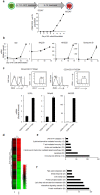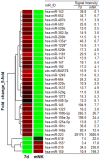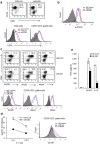Integrated mRNA-microRNA profiling of human NK cell differentiation identifies MiR-583 as a negative regulator of IL2Rγ expression
- PMID: 25313504
- PMCID: PMC4196775
- DOI: 10.1371/journal.pone.0108913
Integrated mRNA-microRNA profiling of human NK cell differentiation identifies MiR-583 as a negative regulator of IL2Rγ expression
Abstract
Natural killer (NK) cells are innate immune effector cells that protect against cancer and some viral infections. Until recently, most studies have investigated the molecular signatures of human or mouse NK cells to identify genes that are specifically expressed during NK cell development. However, the mechanism regulating NK cell development remains unclear. Here, we report a regulatory network of potential interactions during in vitro differentiation of human NK cells, identified using genome-wide mRNA and miRNA databases through hierarchical clustering analysis, gene ontology analysis and a miRNA target prediction program. The microRNA (miR)-583, which demonstrated the largest ratio change in mature NK cells, was highly correlated with IL2 receptor gamma (IL2Rγ) expression. The overexpression of miR-583 had an inhibitory effect on NK cell differentiation. In a reporter assay, the suppressive effect of miR-583 was ablated by mutating the putative miR-583 binding site of the IL2Rγ 3' UTR. Therefore, we show that miR-583 acts as a negative regulator of NK cell differentiation by silencing IL2Rγ. Additionally, we provide a comprehensive database of genome-wide mRNA and miRNA expression during human NK cell differentiation, offering a better understanding of basic human NK cell biology for the application of human NK cells in immunotherapy.
Conflict of interest statement
Figures







Similar articles
-
MicroRNA transcriptomes of distinct human NK cell populations identify miR-362-5p as an essential regulator of NK cell function.Sci Rep. 2015 Apr 24;5:9993. doi: 10.1038/srep09993. Sci Rep. 2015. PMID: 25909817 Free PMC article.
-
Unraveling the expression of microRNA-27a* & NKG2D in peripheral blood mononuclear cells and natural killer cells of pediatric systemic lupus erythematosus patients.Int J Rheum Dis. 2017 Sep;20(9):1237-1246. doi: 10.1111/1756-185X.13099. Epub 2017 May 19. Int J Rheum Dis. 2017. PMID: 28523761
-
Next-generation sequencing identifies the natural killer cell microRNA transcriptome.Genome Res. 2010 Nov;20(11):1590-604. doi: 10.1101/gr.107995.110. Epub 2010 Oct 8. Genome Res. 2010. PMID: 20935160 Free PMC article.
-
Positive and negative modulation of viral and cellular mRNAs by liver-specific microRNA miR-122.Cold Spring Harb Symp Quant Biol. 2006;71:369-76. doi: 10.1101/sqb.2006.71.022. Cold Spring Harb Symp Quant Biol. 2006. PMID: 17381319 Review.
-
Regulation of the MIR155 host gene in physiological and pathological processes.Gene. 2013 Dec 10;532(1):1-12. doi: 10.1016/j.gene.2012.12.009. Epub 2012 Dec 14. Gene. 2013. PMID: 23246696 Review.
Cited by
-
The epigenetic hallmarks of immune cells in cancer.Mol Cancer. 2025 Mar 5;24(1):66. doi: 10.1186/s12943-025-02255-4. Mol Cancer. 2025. PMID: 40038722 Free PMC article. Review.
-
Natural Killer Cells as Key Players of Tumor Progression and Angiogenesis: Old and Novel Tools to Divert Their Pro-Tumor Activities into Potent Anti-Tumor Effects.Cancers (Basel). 2019 Apr 1;11(4):461. doi: 10.3390/cancers11040461. Cancers (Basel). 2019. PMID: 30939820 Free PMC article. Review.
-
Meta-analysis of miRNA expression profiles for prostate cancer recurrence following radical prostatectomy.PLoS One. 2017 Jun 26;12(6):e0179543. doi: 10.1371/journal.pone.0179543. eCollection 2017. PLoS One. 2017. PMID: 28651018 Free PMC article.
-
Granzyme mRNA-miRNA interaction and its implication to functional impact.Genes Genomics. 2024 Dec;46(12):1495-1506. doi: 10.1007/s13258-024-01578-8. Epub 2024 Nov 12. Genes Genomics. 2024. PMID: 39528794
-
Role of Epigenetic Regulation in Plasticity of Tumor Immune Microenvironment.Front Immunol. 2021 Apr 2;12:640369. doi: 10.3389/fimmu.2021.640369. eCollection 2021. Front Immunol. 2021. PMID: 33868269 Free PMC article. Review.
References
-
- Di Santo JP (2006) Natural killer cell developmental pathways: a question of balance. Annu Rev Immunol 24: 257–286. - PubMed
-
- Galy A, Travis M, Cen D, Chen B (1995) Human T, B, natural killer, and dendritic cells arise from a common bone marrow progenitor cell subset. Immunity 3: 459–473. - PubMed
-
- Blom B, Spits H (2006) Development of human lymphoid cells. Annu Rev Immunol 24: 287–320. - PubMed
-
- Boggs SS, Trevisan M, Patrene K, Geogopoulos K (1998) Lack of natural killer cell precursors in fetal liver of Ikaros knockout mutant mice. Nat Immun 16: 137–145. - PubMed
Publication types
MeSH terms
Substances
LinkOut - more resources
Full Text Sources
Other Literature Sources
Molecular Biology Databases

